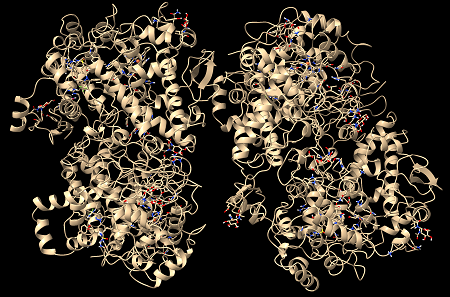Computer Software Brings Wonderment and Support to Chemistry

LEXINGTON, Va., May 2, 2023—Visualizing three-dimensional (3D) molecules on a two-dimensional piece of paper can be a struggle for any chemistry student. Add the fact that molecules can vibrate, rotate, and migrate, and it is no mystery that grasping that concept without being able to see it, can be frustrating.
Lt. Col. Dan Harrison ’05, associate professor in the Department of Chemistry at Virginia Military Institute, has noticed the struggle with his general chemistry cadets. “We have observed a deficiency within the cadets of being able to visualize molecules and how they interact. In addition, in the course evaluations we receive from cadets at the end of the semester, they tell us that there seems to be a disconnect between what is taught in general chemistry class, and what I teach in the lab. That is concerning, and we want to fix that problem,” said Harrison.
The faculty in the chemistry department strive to improve their curriculum with the times and technology available, and Harrison has been seeking out tools to help his students develop basic chemistry skills in a way that is accessible to all students. He has used proprietary software in his research for decades, but it was extremely expensive, making it financially prohibitive and inaccessible to students. Over the last five years, Harrison discovered and trialed two free research-grade computer programs, called ORCA and ChimeraX - even publishing peer-reviewed work with them - and recognized that the pair had the potential to improve 3D visualization and thermodynamic skills, as well as the free accessibility to students. He collaborated with his colleague, Lt Col. Kevin L. Braun, associate professor, and STEM general chemistry course and laboratory coordinator, and together they worked closely to build a vision, plan, and execute this project. Used together, the programs provide exactly the solution they had sought to aid the cadets. Harrison introduced the software into the General Chemistry Lab II for STEM majors this spring in collaboration with Braun.
“We have pioneered a way for every cadet to use their own computer to model the 3D structure and properties of molecules, and model their vibrations. We have taught the cadets computer skills with the software, and the analysis with this software is serving as a common thread in nearly all experiments. Major Kaitie Cartwright, who teaches classroom chemistry, and I have worked together to interweave the content of the lab and lecture. We hope that there should no longer be a perceived disconnect between the classroom work and the lab work,” said Harrison.
According to Braun, the software is having a noticeable impact on the cadets. “They are digging deeper and asking better questions. There is a wonderment that comes when they see the 3D molecules on their laptops. It helps fit all the puzzle pieces together,” he said.
Will Hundley ’24, a biology major, had a solid foundation in chemistry and an intrinsic desire to explore the implications of chemistry at a molecular level within the realm of biology, but he struggled with visualizing basic molecular interactions and models. “My struggles ended when I took Lieutenant Colonel Harrison's chemistry lab this semester, where I was exposed to the intricate world of computational chemistry. We conducted hands-on experiments, but also utilized the software programs to compute the labs we had performed. In comparison to previous chemistry labs, where we simply carried out experiments and completed worksheets, the software allowed us to build molecules and calculate various molecular properties, such as vibrational frequency, unknown molecular identities, and purity of unknown synthesized compounds. As the semester draws to an end, I can now not only visualize molecular interactions, but I have also developed a strong understanding of what happens when reactants are mixed. Furthermore, my appreciation and interest in the study of chemistry has deepened, as the topics covered in the course went beyond basic molecular interactions. I am excited to apply what I have learned to future chemistry and biology courses,” said Hundley.
Kern Aughinbaugh ’26, also a biology major, agrees. “While the programs were challenging at the beginning of the course and pushed me to the brink of dropping the class, the professor's dedication and effort helped me persevere. The first half of the semester I completed maybe 10 percent of the assignments, but with continuous work and time spent on the program, I finally figured it out and developed an appreciation for it,” he said.
Harrison and Braun agree that using the power of computers is not exclusive to chemistry, and that cadets studying other STEM (science, technology, engineering, mathematics) subjects benefit from using discipline specific computational software. “We are considering publishing our work in the Journal of Chemical Education at some point in the future,” stated Harrison.
Marianne Hause
Communications & Marketing
VIRGINIA MILITARY INSTITUTE
.svg)
.png)